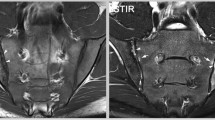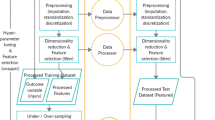Abstract
Meniscal tear is one of the prevalent knee disorders among young athletes and the aging population, and requires correct diagnosis and surgical intervention, if necessary. Not only the errors followed by human intervention but also the obstacles of manual meniscal tear detection highlight the need for automatic detection techniques. This paper presents a type-2 fuzzy expert system for meniscal tear diagnosis using PD magnetic resonance images (MRI). The scheme of the proposed type-2 fuzzy image processing model is composed of three distinct modules: Pre-processing, Segmentation, and Classification. λ-nhancement algorithm is used to perform the pre-processing step. For the segmentation step, first, Interval Type-2 Fuzzy C-Means (IT2FCM) is applied to the images, outputs of which are then employed by Interval Type-2 Possibilistic C-Means (IT2PCM) to perform post-processes. Second stage concludes with re-estimation of “η” value to enhance IT2PCM. Finally, a Perceptron neural network with two hidden layers is used for Classification stage. The results of the proposed type-2 expert system have been compared with a well-known segmentation algorithm, approving the superiority of the proposed system in meniscal tear recognition.






























Similar content being viewed by others
References
De Smet AA, Norris MA, Yandow DR: MR diagnosis of meniscal tears of the knee: importance of high signal in the meniscus that extends to the surface. American Journal of Roentgenology 161:101–107, 1993
Bowers ME, Tung GA, Fleming BC, Crisco JJ, Rey J: Quantification of meniscal volume by segmentation of 3T magnetic resonance images. Journal of Biomechanics 40(12):2811–2815, 2007
FazelZarandi MH, Zarinbal M, Izadi M: Systematic image processing for diagnosing brain tumors: a type-2 fuzzy expert system approach. Applied Soft Computing 11(1):285–294, 2009
Kostopoulos S, Sidiropoulos K, Glotsos D, Athanasiadis E, Konstantina B, Lavdas E, Oikonomou G, Fezoulidis IV, Vlychou M, Hantes M, Cavouras D: A systematic approach to magnetic resonance imaging evaluation of epiphyseal lesions. Magnetic Resonance Imaging 31(3):418–431, 2013
J.M. Mendel, R.I. John, Type-2 fuzzy sets made simple. IEEE Transactions on fuzzy systems 2002 10 117–127.
J.M. Mendel, R.I. John, F. Liu, Interval type-2 fuzzy logic systems made simple. IEEE Transactions on fuzzy systems 2006 14 808–821.
Hough Jr, AJ, Webber RJ: Pathology of the meniscus. Clinical Orthopedics and Related Research 252:32–40, 1990
Houston Methodist Orthopedics & Sports Medicine. http://www.methodistorthopedics.com
Scott, W.N., Surgery of the knee. Elsevier Inc., 2006.
Fox MG: MR imaging of the meniscus: review, current trends, and clinical implications. Magnetic Resonance Imaging Clinics of North America 15(1):103–123, 2007
McCarty EcFau—Marx, R.G., T.L. Marx RgFau—Wickiewicz, and T.L. Wickiewicz, Meniscal tears in the athlete. Operative and nonoperative management, 2000. 28(8): p. 1308–1316.
Helms CA: The meniscus: recent advances in MR imaging of the knee. American Journal of Roentgenology 179(5):1115–1122, 2002
Ramakrishna B, et al: An automatic computer-aided detection system for meniscal tears on magnetic resonance images. Medical Imaging, IEEE Transactions on 28(8):1308–1316, 2009
C. Köse et al. An automatic diagnosis method for the knee meniscus tears in MR images. Expert systems with applications,2009. 36(2): p. 1208 – 1216.
Pohle R., & Toennies, K. Segmentation of medical images using adaptive region growing. Medical imaging,2001. SPIE 4322.
Wright DH, De Smet AA, Norris M: Bucket-handle tears of the medial and lateral menisci of the knee: value of MR imaging in detecting displaced fragments. American Journal of Roentgenology 165(3):621–625, 1995
Ja-Chih F, Lin C-C, Wang C-N, Yang-Kun O: Computer-aided diagnosis for knee meniscus tears in magnetic resonance imaging. Journal of Industrial and Production Engineering 30(2):67–77, 2013
Hata Y, Kobashi S, Tokimoto S, Ishikawa M, Ishikawa H: Computer-aided diagnosis system of meniscal tears with T1- and T2-weighted MR images based on fuzzy inference. Lecture Notes Computer Science 2206:55–58, 2001
J. Waterton, S. Solloway, J. Foster, M. keen, S. Gandy, B. Middleton, R. Maciewicz, I. Watt, P. Dieppe, and C. Taylor. Diurnal variation in the femoral articular cartilage of the knee in young adult humans. Magnetic Resonance Medicine,2000. 43: p. 126–132.
Fripp J, Bourgeat P, Crozier S, Ourselin S: Segmentation of the bones in MRIs of the knee using phase, magnitude, and shape information. Academic Radiology 14(10):1201–1208, 2007
Tang J, Millington S, Acton ST, Crandall J, Hurwitz S: Surface extraction and thickness measurement of the articular cartilage from MR images using directional gradient vector flow snakes. IEEE Transactions Biomedical Engineering 53(5):896–907, 2006
Stammberger T, Eckstein F, Englmeier K, Reiser M: Determination of 3D cartilage thickness data from MR imaging: computational method and reproducibility in the living. Magnetic Resonance medicine 41:529–536, 1999
Li K, Millington S, Wu X, Chen DZ, Sonka M: Simultaneous segmentation of multiple closed surfaces using optimal graph searching. Proceedings International Conference on Information Processing in Medical Imaging 3565:406–417, 2005
Hu L, Cheng HD, Zhang M: A high performance edge detector based on fuzzy inference rules. Information sciences 177(21):4768–4784, 2007
L.A. Zadeh. The concept of a linguistic variable and its applications to approximate reasoning. Information sciences,1975. 8: p. 199–249.
P. Melin, O. Castillo. Hybrid Intelligent Systems for Pattern Recognition Using Soft Computing. Springer-Verlag,2005.
O. Castillo, P. Melin. Type-2 Fuzzy Logic: Theory and Applications. Springer-Verlag,2008.
FazelZarandi MH, Turksen IB, TorabiKasbi O: Type-2 fuzzy modeling for desulphurization of steel process. Expert Systems with Applications 32:157–171, 2007
Turksen IB: Type-2 representation and reasoning for CWW. Fuzzy Sets and Systems 127:17–36, 2002
V. Kuperman. Magnetic Resonance Imaging: Physical Principles and Applications. Academic Press,2000.
M.H. FazelZarandi, M. Zarinbal, I. B.Turksen. Type-2 Possibilistic C-Means Clustering. IFSA-USEFLAT,2009. p. 30–35.
Tizhoosh, H.R., G. Krell, and B. Michaelis. λ-Enhancement: contrast adaptation based on optimization of image fuzziness. IEEE International Conference on Fuzzy Systems, 1998. 2: p. 1548–1553.
Kwon SH: Cluster validity index for fuzzy clustering. Electronics Letters 34(22):2176–2177, 1998
FazelZarandi MH, Rezaee B, Turksen IB, Neshat E: A type-2 fuzzy rule based expert system model for stock price analysis. Expert Systems with Applications 36:139–154, 2009
Young Sik C, Krishnapuram R: A robust approach to image enhancement based on fuzzy logic. Image Processing, IEEE Transactions on 6(6):808–825, 1997
Tizhoosh HR: Image thresholding using type II fuzzy sets. Pattern Recognition 38(12):2363–2372, 2005
Tizhoosh, H.R., Adaptive λ-enhancement: type-1 versus type-2 fuzzy implementation. IEEE Symposium on Computational Intelligence in Image Processing, CIIP—Proceedings, 2009.
J.V. Oliveira, W. Pedrycz. Advances in Fuzzy Clustering and its Applications. John Wiley and Sons Ltd., 2007.
Hwang, C. and F.C.H. Rhee, Uncertain fuzzy clustering: interval type-2 fuzzy approach to C-means. IEEE Transactions on Fuzzy Systems, 2007. 15(1): p. 107–120.
Rhee, F.C.H. and C. Hwang. A type-2 fuzzy C-means clustering algorithm. Annual Conference of the North American Fuzzy Information Processing Society—NAFIPS, 2001.
Krishnapuram, R. and J.M. Keller, Possibilistic approach to clustering. IEEE Transactions on Fuzzy Systems, 1993. 1(2): p. 98–110.
Zadeh, L.A., Fuzzy sets as a basis for a theory of possibility. Fuzzy Sets and Systems 1999. 100 Supplement 1(0) p. 9–34.
Min, J.H., E.A. Shim, and F.C.H. Rhee. An interval type-2 fuzzy PCM algorithm for pattern recognition. IEEE International Conference on Fuzzy Systems. 2009. p. 480–483.
M.H. FazelZarandi, M.R. Faraji, and M. Karbasian, An exponential cluster validity index for fuzzy clustering with crisp and fuzzy data. Scientia Iranica, 2010. 17(2): p. 95–110.
Karnik, N.N. and J.M. Mendel. Introduction to type-2 fuzzy logic systems. IEEE International Conference on Fuzzy Systems, 1998. p. 643–658.
Karnik, N.N. and J.M. Mendel, Centroid of a type-2 fuzzy set. Information Sciences, 2001. 132: p. 195–220.
Tizhoosh HR: Type-II fuzzy image segmentation; fuzzy sets and their extensions: representation, aggregation and models. Studies in Fuzziness and Soft Computing 220:607–619, 2008
Author information
Authors and Affiliations
Corresponding author
Rights and permissions
About this article
Cite this article
Zarandi, M.H.F., Khadangi, A., Karimi, F. et al. A Computer-Aided Type-II Fuzzy Image Processing for Diagnosis of Meniscus Tear. J Digit Imaging 29, 677–695 (2016). https://doi.org/10.1007/s10278-016-9884-y
Published:
Issue Date:
DOI: https://doi.org/10.1007/s10278-016-9884-y




